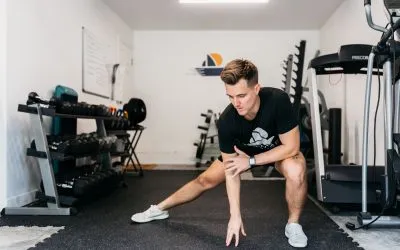Hamstring protection is crucial for every runner, whether you’ve just run your first full mile or are decades into your running experience. No matter where you are in your fitness journey, the basic tenets of hamstring maintenance are the same. Unfortunately, that doesn’t mean there aren’t mistakes that even seasoned runners make when it comes to avoiding injury and maximizing their performance. Today, we’re going over some of the most important things to keep in mind if you want to continue progressing as a runner while minimizing your risk of injury. Let’s get into it.
Never Skip a Warmup
Lots of people can make the mistake of viewing running as their warm up, but the truth is that it’s important to work up to your full-out speed in order to avoid cramping and injury. Try starting off by walking for about a quarter- to half-mile and building up your speed. Speak with a trusted professional, like a sports physician or physical therapist, to get their recommendations for dynamic warmups that work for your needs. Don’t neglect your warm-ups; they are one of your best lines of defense against injury and discomfort as a runner, both in your hamstrings and other leg muscles.
Form = Function
In running and in any kind of physical activity, good form yields more than better results: it’s instrumental to injury prevention. No two runners will have identical form; however, there are important ground rules that every runner should know about in order to prevent unnecessary strain and injury. The best way to evaluate whether your form is correct and conducive to safety is to have it evaluated by a physical therapist. Generally speaking, though, pay attention to a few factors in your form:
- Relax your upper body. Running is whole-body exercise, and tense shoulders and backs can lead to undue strain being placed on your lower body.
- Keep your strides short. Longer strides do not mean longer distances. You should be landing just in front of your center of gravity on your strides. Longer strides than that place you at risk for injury.
- You should be landing on the middle of your foot when you run, not on your heels. The majority of runners do run with heel-strike pattern, however, it’s good to explore landing midfoot
- Remain light on your feet. Pounding your feet against the ground just requires more energy, placing more of a strain on your leg muscles and slowing you down over time.
Stretch!
Stretching is a great way to cool down. By being consistent about stretching after your runs, you’ll help to promote flexibility and mobility, all while transitioning from “workout” mode back into your day-to-day.
Address Pain with a Professional
Ultimately, the best thing you can do in order to prevent hamstring injuries as much as possible is to work with a great physical therapist. Physical therapy is about so much more than treating injuries; it’s about maximizing performance, improving strength and flexibility, and preventing injuries over time through good programming, exercise dosing, and modifications as necessary by your physical therapist.. If you’ve experienced hamstring discomfort, have a hamstring injury you want to keep from exacerbating, or are simply interested in hamstring protection, we highly encourage you to consult with a physical therapist and come up with a treatment plan that fits your needs, goals, and lifestyle.
Hamstring protection is extremely important for runners, and working with a physical therapist is the best way to make the most of your hamstring protection plan. At Purpose, our goal is to create custom physical therapy plans to help each patient reach and exceed their goals. To schedule your first consultation with Dr. Ken Clark, click here.


